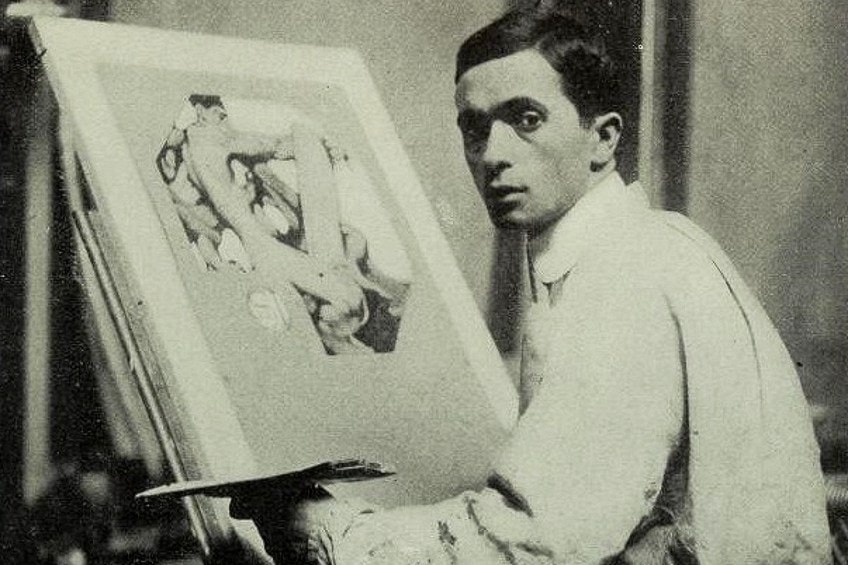J. C. Leyendecker – The Art Nouveau Works of This German Artist
Boasting a portfolio of over 400 magazine covers, this German-American Art Nouveau illustrator is one to remember. Read on for more information on Joseph Christian Leyendecker, including some of his most famous Leyendecker paintings of the early 20th century.
J. C. Leyendecker: Inventor of the Modern Magazine Cover
Born in 1874, Joseph Christian Leyendecker went on to become one of the most revered American artists of the early 20th century. The German artist had amassed an astounding portfolio of just over 400 cover illustrations executed between 1896 and 1950. Having worked for the Saturday Evening Post, Leyendecker generated approximately 322 artworks along with numerous advertisement illustrations.
Today, he is recognized as the man behind the creation of the modern magazine cover style.
| Artist Name | Joseph Christian Leyendecker (Joe) |
| Date of Birth | 23 March 1874 |
| Date of Death | 25 July 1951 |
| Country of Birth | Rhine province, German Empire |
| Nationality | German-American |
| Art Movements | Art Nouveau |
| Mediums Used | Lithography, painting, illustration |
| Dominant Themes | Magazine illustration, advertising posters, branding imagery, book covers |
Joseph Christian Leyendecker: Early Life and Rise to Fame
J. C. Leyendecker was born in Montabaur, Germany on March, 23 of 1874, and was the firstborn son of parents, Peter and Elizabeth Leyendecker. Joseph’s brother, Francis Xavier, was born three years later and his sister, Mary, was born later and was the last child born after the family’s relocation to America in 1882. The Leyendeckers settled in Chicago with one connection being Joseph’s uncle, Adam Ortseifen who also happened to be the Vice President of McAvoy Brewing Company.
J. C. Leyendecker began his career in illustration during his adolescence when he worked for an engraving firm called J. Manz & Company.
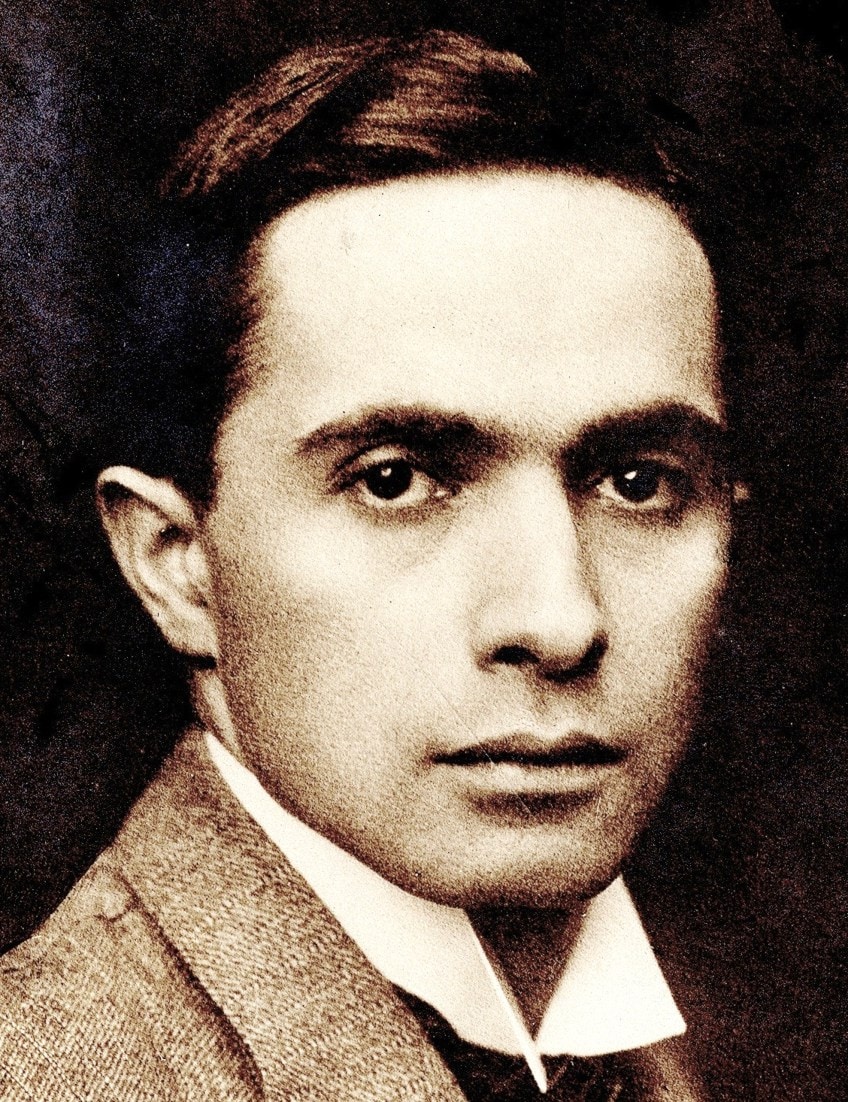
J. C. Leyendecker’s first commission was to complete 60 illustrations for the Bible under the Power Brothers Company. Thereafter, Leyendecker went on to complete his formal art studies at the Chicago Art Institute.
The April to September issue of “The Inland Printer” of 1895 published an article that introduced Leyendecker, outlining his intentions to study where all talented illustrators and artists moved to – Paris.
The article showcased one of Leyendecker’s sketches alongside two book cover illustrations, as provided by a Chicago-based publisher, E. A. Weeks. In the same year, Leyendecker produced his first poster and book cover for E. A. Weeks in the book, One Fair Daughter (1895) by Frank Moore.

While studying at the Chicago Art Institute, the young J. C. Leyendecker took up drawing and anatomy under the tutelage of John Vanderpoel. Later on, Leyendecker, alongside his brother Frank, studied at the Academie Julian in Paris for one year where they were both exposed to the art of other great painters and illustrators of the Art Nouveau movement such as Alphonse Mucha and Henri de Toulouse-Lautrec.
Around 1899, the Leyendeckers moved back to America, this time to Hyde Park, and opened up their own studio at the Chicago Fine Arts building. Joseph Leyendecker then got his first commission to create a cover for the Saturday Evening Post, which was soon to be one of the most popular and widely distributed magazines of the early 20th century.
A big break indeed for the young Leyendecker!

At that point, Leyendecker had no idea as to the relationship that would be built and go on to last for over 44 years with the Saturday Evening Post. In 1900, the Leyendecker siblings moved to the big apple, New York City, which was then the main hub of the commercial art world, boasting the best publishing and advertising companies.
Throughout his career, Leyendecker had accumulated numerous clients and worked with major companies such as Cluett Peabody & Company and the famous Kellogg Company.
Important Commissions
Among the important commissioned works are the commissions Leyendecker did for the Arrow Collar Man and the Kuppenheimer Suits and Interwoven Socks, which propelled the brands into popularity among male audiences and established the fashion of the time.
The Arrow Collar Man
The Arrow Collar Man was a name attributed to the male models who modeled for shirts and the detachable collars created by the New York company, Cluett Peabody & Company. The company made thousands of printed advertisements featuring Leyendecker’s commercial illustrations, including the illustrator’s romantic partner and model, Charles Beach.
The Arrow Collar Man was also a fictional figure used solely for the purpose of creating a group of characters that would become fashion icons and the ultimate vision of a 20th-century man, defined by the collar and brand.
As with famous celebrities today, fans collect merchandise and images of their favorite icons. Similarly, back then, the Arrow Collar Man even received fan mail and if you were a model, you would automatically become an icon too and have your poster hung on a wall. The sensational Arrow Collar Man became known as one of the greatest advertising campaigns in history and was eventually sold to Phillips-Van Heusen in 2004 and the Authentics Brand Group in 2021.

The Kellogg Company Kids
A name known to all, the Kellogg’s food manufacturing company had also approached Leyendecker for illustrations for their cereal product, Corn Flakes, in 1912. The advertising campaign required Leyendecker to design 20 illustrations of “Kellogg’s kids”, which can be seen at the J. C Leyendecker Gallery in the Haggin Museum in Stockton, California.
The series consists of cherub-like faces of kids and young adolescents enjoying a bowl of Kellogg’s Corn Flakes.
These rosy-cheeked kids represented the epitome of bliss and joy that the innocent kids sold to the public and invited interested buyers to want to buy the product and spread the child-like wonder of munching on a fresh bowl of cereal, first thing in the morning.
Recruitment Illustrations for the United States Military
Another important segment of Leyendecker’s long career in illustration moved from magazine and book works to branding and illustration for the advertisement of potential candidates for the United States Military. Leyendecker contributed to the development of many posters during World War I alongside commissions for men’s fashion, magazines, and book covers.
Leyendecker was a man in demand.
In an example of one of Leyendecker’s US Navy recruitment posters, one can observe his clever use of the figure of Libertas, who was a symbol of American freedom. The Statue of Liberty is an important military figure since it was used by the US Lighthouse Board as a navigational tool for sailors. After 1901, the statue fell under the jurisdiction of the US War department.

It is just as important to note the impact that war-time posters and propaganda imagery had on the public during World War I and II. The propaganda illustrator, Leyendecker, represented Liberty as America shaking the hand of a navy personnel equipped with arms and presumed ready for battle. The image may also imply that America congratulates those who join the war and is a symbol of collaboration with America herself, for her sake.
The power of the imagery in this poster would have had the intended effect, that was, to gain new recruits and increase the manpower of America.
This brings us to a new point for consideration in the greater scheme of art, power, propaganda, and war. The power lies in the hand of the illustrator, as seen in Leyendecker’s works, to elicit the goals and intentions of companies and institutions for commercial gain.
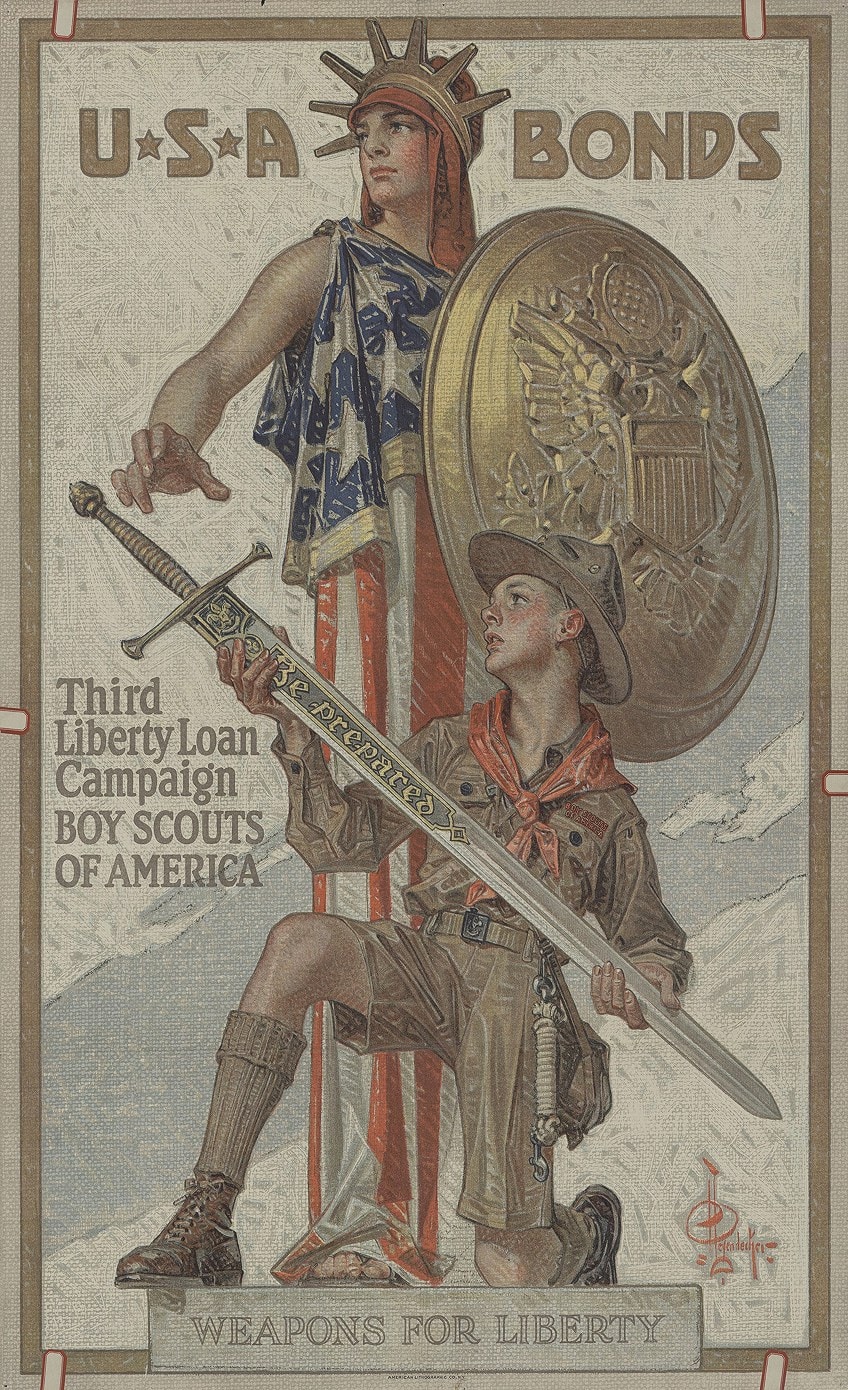
This also brings to the fore the psychology within illustrations like Leyendecker’s advertisement for the US Military, coupling the image with the statement “America Calls. Enlist in the Navy.” These are both commands or statements rather than requests. Leyendecker leverages the civilians’ duty to America to join the Navy and thus anyone who would disregard the call would also be identified as someone who did not listen to America herself.
Never underestimate the power of illustration during important political and social events.
Leyendecker’s Santa Clause
J.C Leyendecker can be considered the pioneering illustrator behind some of America’s most iconic images. One such image was the birth of the jolly, robust Santa Clause with a red-trimmed fur coat. The image of the bubbly white-bearded old man was later further popularized by Norman Rockwell, who was a great admirer of Leyendecker’s illustrations. Santa Clause can also be seen in one of the 1925 magazine covers for the Saturday Evening Post, which shows Santa Clause bending down to hug the little boy.
The image depicts Santa Clause as a self-sacrificing figure as he carries a massive sack of gifts and goodies while making room to strenuously hug a child.
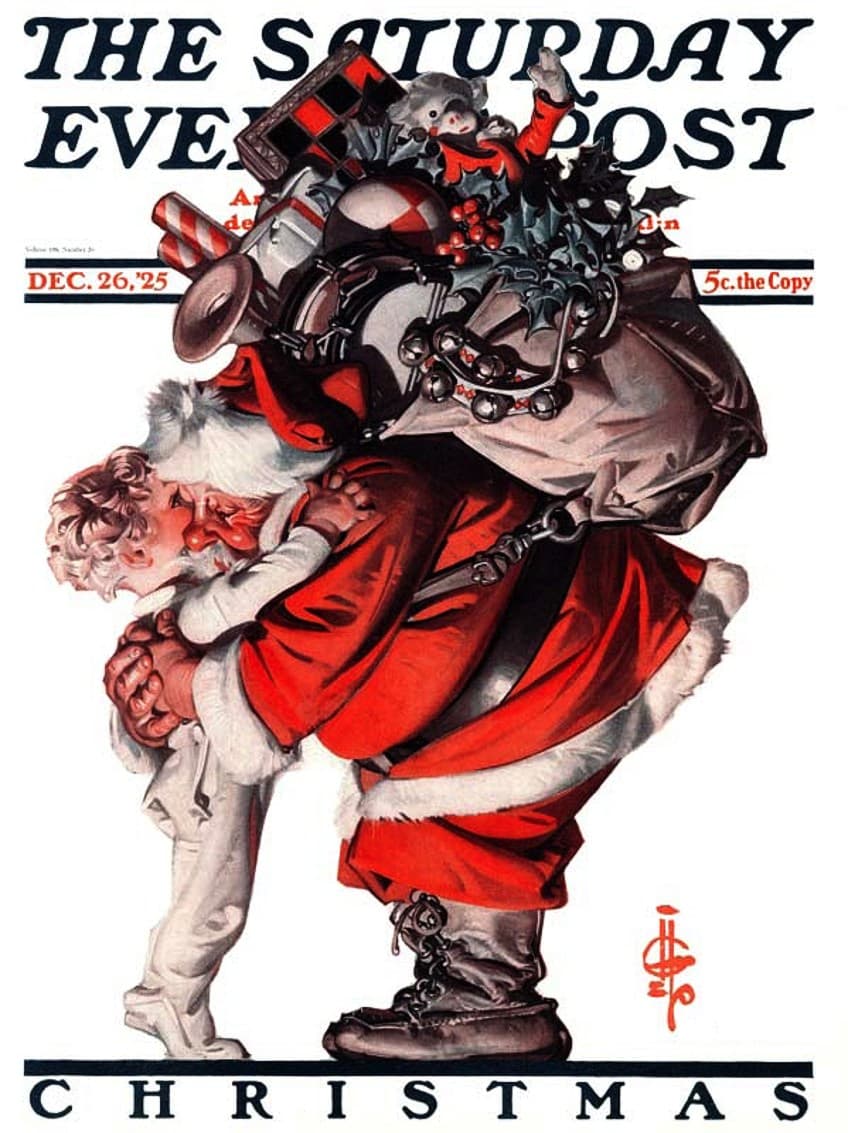
Leyendecker’s Legacy and Death
The career of Joseph Christian Leyendecker reached its climax in the 1920s with most of his illustrations becoming highly recognized. The 1920s also coincided with the emergence of modern advertising, which was made evident in the clever psychological tactics to appeal to the public. Modern advertising during the 1920s made use of youthfulness, intelligence, popularity, and other traits seen as desirable to appeal to the public.
This also saw the trend of advertising where people were encouraged to buy products that were innovative and “new and improved”.
As a well-established commercial artist, Leyendecker was also incredibly popular outside of his commercial art bubble. Alongside his partner, Charles Beach, Leyendecker hosted many galas that attracted prominent figures from all sectors. We can say that Leyendecker was something of a celebrity himself. The large social gatherings received many influencers and were known to be a celebrity mixing event. Unfortunately, along with the social success came personal events that shook the artist’s personal life. Leyendecker’s brother Frank had fallen into an addiction-driven lifestyle and sadly passed away in 1924.
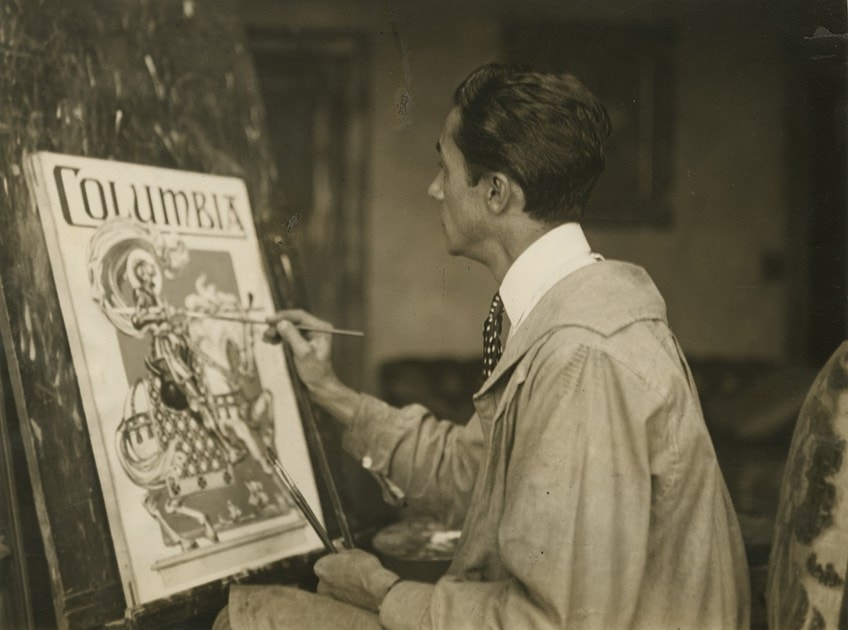
Following the boom of the 1920s came the anticlimax of the 1930s when Leyendecker’s supporters, Cluett Peabody & Company, saw a massive decline in demand. This meant that Leyendecker was not needed and the company stopped using his illustrations. The reality of the time was also heightened by the 1929 economic crash of Wall Street and Leyendecker was further driven into the line of fire. His commission rate began to drop and soon after the replacement of the Saturday Evening Post editor, Leyendecker was not as popular in the magazine as before. Talk about one bad luck after another.
Leyendecker’s last illustration for the magazine mogul was the famous New Year baby, published in 1943, which marked the end of the illustrator’s wave of fame as a commercial illustrator.
Throughout his relationship with the Saturday Evening Post, he created a total of 322 covers, including the most iconic images of the fourth of July firecrackers, Santa Clause, and the New Year’s baby. This is not to say that his entire career was dead; instead, the rate of his commissions only declined. Among his last works were his posters for the US Department of War to encourage the procurement of bonds. J. C. Leyendecker died in 1951 due to an acute coronary occlusion.

Most Famous Leyendecker Paintings
Now that we have a sense of the level of talent and skill that Leyendecker possessed, let us visualize it for you. Below, you will find a list of famous J. C. Leyendecker artworks created by the Art Nouveau German illustrator and painter.
New Year’s Baby (1907)
| Date | 1907 |
| Medium | Oil on canvas |
| Dimensions (cm) | 60.9 x 50.8 |
| Where It Is Housed | The Illustrated Gallery |
This signed oil image was created for use in the iconic New Year’s issue of the Saturday Evening Post. The New Year’s Baby (1907) is a classic image associated with the narrative of a baby being delivered by a tall stork.
The baby is painted with a tiny pair of wings and is seen innocently gazing ahead in a distracted manner while placing one finger in the mouth.
The appeal of the blonde-haired rosy-cheeked ideal baby of the early 20th century being delivered by a stork originates from a Greek narrative. In the story, Hera, the wife of Zeus, transforms a beautiful queen, Gerana, into a stork out of jealousy. Gerana then set out on a mission to retrieve her child, who was captured by Hera.

Circus Dog (1922)
| Date | 1922 |
| Medium | Oil on canvas |
| Dimensions (cm) | 68.5 x 50.8 |
| Where It Is Housed | The Illustrated Gallery |
The power of this Leyendecker painting lies in its composition. The dynamism of the clown is showcased through his stance, which takes up the majority of the painting’s background. The poodle is depicted jumping through the hoop in motion and adds to the viewer being thrown into the scene as if witnessing the circus act firsthand.
Leyendecker skillfully used painting techniques to allude to the false sense of light emanating from below, highlighted on the clown’s chin to emphasize the dramatic nature of the illustration.
Most J. C. Leyendecker artworks contained a limited color palette due to the limited availability of printing technology at the time, so the illustrator was required to use a combination of whites, blacks, and reds. Leyendecker also expertly sets up a sense of rhythm in the painting to draw the attention of the viewers, resulting in an excellent display of visual communication.

Study for Butterfly Couple (1923)
| Date | 1923 |
| Medium | Oil on canvas |
| Dimensions (cm) | 43.1 x 33 |
| Where It Is Housed | The Illustrated Gallery |
This Leyendecker artwork is a small yet detailed study of a couple embracing each other while sharing a kiss. The couple is seen illustrated with butterfly wings, appealing to the fairy-tale narrative of the happily ever after.
The illustration from the painting was also used on an advert for Kuppenheimer clothing with the caption reading “when the occasion calls for a good appearance”.
First Long Suit (1937)
| Date | 1937 |
| Medium | Oil on canvas |
| Dimensions (cm) | 70.4 x 56.5 |
| Where It Is Housed | The Illustrated Gallery |
First Long Suit (1937) evokes a mother’s sentiment of watching her son grow up before her eyes during his introduction to the hit fashion of the time. The glamor associated with the long suit is represented as a rite of passage and an ode to the successful career that Leyendecker himself strived to achieve.
In the painting, one immediately draws attention to the boy’s mother who is seen shedding a tear over her son’s first fitting with his tailor. While many may think that the young boy is the main attraction, the appeal to a mother’s experience is one that speaks volumes. Leyendecker makes use of his famous cross-hatching technique paired with shades of vibrant salmon, a butter yellow, and rich earthy blues and browns.
The colors suggest refinement and capture a moment that is treasured by both young and old.

According to an interview with a former literature professor, Alfredo Villanueda-Collado, who took a strong interest in Leyendecker’s works at the time, commented on the illustrator’s display of sexuality in his artworks. He recognized the artist as homosexual for integrating a technique called the palimpsest technique, suggesting that Leyendecker’s works contained subtext and subliminal suggestions that focus on specific details of the models in the posters. During the time, homosexuality and the idea of breaking the norm was something of an outrage.
Today, Leyendecker can be considered the man who paved the way for queer representation in early 20th-century American art and media.
Top Reads on J. C. Leyendecker
The legendary American artist, Joseph Christian Leyendecker left quite the legacy behind, becoming one of America’s best Golden Age illustrators of the early 20th century. Below, we have compiled a list of highly-rated books that shed more insight on the works and life of this prolific artist, which can be found on Amazon.
J. C. Leyendecker (1974) by Michael Schau
J. C. Leyendecker (1974) contains an in-depth exploration and review of the works of J. C. Leyendecker from 1899 to 1943. The book also contains more than 200 monochromatic reproductions and 64-pages of full color to please your visual appetite. According to fans, this hardcover contains imagery of artworks “never seen before”. If you are a die-hard fan of Leyendecker after reading this article, be sure to add this book to your next Amazon purchase.
- The art of J. C. Leyendecker is fully explored for the first time
- A well-researched and well-documented study
- Over 200 black-and-white illustrations as well as 64 full-color pages
The J. C. Leyendecker Collection: American Illustrators Poster Book (1995) by Kent Steine and Frederic B. Taraba
Available in both hardcover and paperback, this book by Kent Steine and Frederic B. Taraba covers the 50-year career of the legendary J. C. Leyendecker, who is one of America’s most overlooked and underrepresented artists and illustrators. Loved by all, this book contains high-quality reproductions of Leyendecker’s paintings, which were photographed directly with many works unpublished. This book is a must-have for any collector of Leyendecker’s works.
- First-quality reproductions of Leyendecker's original works
- Includes many works that have never before been published
J. C. Leyendecker: American Imagist (2008) by Laurence S. Cutler and Judy Goffman Cutler
Published in 2008, this book by Laurence S. Cutler and Judy Goffman Cutler is the first book on Joseph Christian Leyendecker in 30 years. The hardcover features around 322 of the artist’s best magazine covers of the early 20th century along with text that covers information on the artist’s personal life and artistic development. Did the book do him justice? With five-star ratings, this book shook the American public since Leyendecker was not as publicized and recognized as much as his contemporaries, Norman Rockwell and Drew Stuzan.
- The first book about J. C. Leyendecker in more than 30 years
- Features the artist's masterworks, rare paintings, studies, and more
- A revealing text that delves into his artistic growth and personal life
Following his death, Leyendecker left behind a few artworks for his partner, Beach and many of his original paintings, as seen above, were sold at a rummage sale for $75. The history behind Leyendecker as a German artist and commercial art illustrator is intriguing and definitely places him back in the spotlight, prior to the appearance of Norman Rockwell.
Frequently Asked Questions
Who Was J. C. Leyendecker?
J. C. Leyendecker, also called Joe or Joseph Christian Leyendecker, was a German-American artist and illustrator who produced numerous illustrations for the Saturday Evening Post and other major clients in the early 20th century.
For Which Illustrations Is J. C. Leyendecker Most Famous?
J. C. Leyendecker is most famous for his illustrations in the Saturday Evening Post, which include illustrations of the New Year’s baby and Santa Clause. Other illustrations that made the artist famous include the Kellogg’s kids for the Kellogg Company and the Arrow Collar Man series for Cluett Peabody & Company.
Why Is J. C. Leyendecker an Important Artist?
J. C. Leyendecker is often underrepresented and is considered important for his contribution to some of America’s most iconic imagery of the early 20th century. Today, Leyendecker is also seen as a leading queer artist and illustrator whose work on the Arrow Collar Man and many other illustrations are seen as crucial to some of the first forms of queer art and depiction of the queer gaze in art.
Isabella studied at the University of Cape Town in South Africa and graduated with a Bachelor of Arts majoring in English Literature & Language and Psychology. Throughout her undergraduate years, she took Art History as an additional subject and absolutely loved it. Building on from her art history knowledge that began in high school, art has always been a particular area of fascination for her. From learning about artworks previously unknown to her, or sharpening her existing understanding of specific works, the ability to continue learning within this interesting sphere excites her greatly.
Her focal points of interest in art history encompass profiling specific artists and art movements, as it is these areas where she is able to really dig deep into the rich narrative of the art world. Additionally, she particularly enjoys exploring the different artistic styles of the 20th century, as well as the important impact that female artists have had on the development of art history.
Learn more about Isabella Meyer and the Art in Context Team.
Cite this Article
Isabella, Meyer, “J. C. Leyendecker – The Art Nouveau Works of This German Artist.” Art in Context. September 14, 2022. URL: https://artincontext.org/j-c-leyendecker/
Meyer, I. (2022, 14 September). J. C. Leyendecker – The Art Nouveau Works of This German Artist. Art in Context. https://artincontext.org/j-c-leyendecker/
Meyer, Isabella. “J. C. Leyendecker – The Art Nouveau Works of This German Artist.” Art in Context, September 14, 2022. https://artincontext.org/j-c-leyendecker/.


